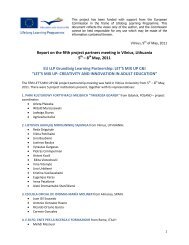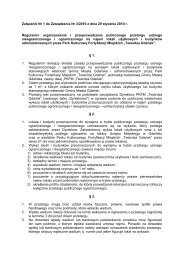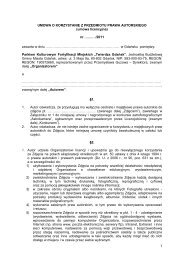AT-Case Study V Experiential Learning
AT-Case Study V Experiential Learning
AT-Case Study V Experiential Learning
Create successful ePaper yourself
Turn your PDF publications into a flip-book with our unique Google optimized e-Paper software.
!<br />
CASE STUDY<br />
EXPERIENTAL LEARNING<br />
&<br />
SELF-ASSESSMENT QUESTIONNAIRE<br />
CRE<strong>AT</strong>OR / AUTHOR<br />
Monika Brunner<br />
PUBLISHER /<br />
ORGANIZ<strong>AT</strong>ION<br />
COVERAGE<br />
COPYRIGHT<br />
CULTURE CIRCLE<br />
EUROPE GRUNDTVIG PARTNERSHIPS<br />
Creativity and Innovation in Adult Education<br />
© 2010 Monika Brunner, Culture Circle<br />
This project has been funded with support from the European Commission.<br />
This document reflects the views only of the author, and the Commission<br />
cannot be held responsible for any use which may be made of the information<br />
contained therein.
INTRODUCTION<br />
Culture Circle recognize that theory is useless if you can’t put it into action. Through<br />
various experiential learning formats, trainees and learners have the chance to test<br />
themselves and their ideas in real-world settings.<br />
Providing trainees and learners with hands-on exposure to real-world situations is a key<br />
strength of the Culture Circle Programmes.<br />
<strong>Experiential</strong> activities are a required part of the coursework, and numerous out-ofclassroom<br />
opportunities also offer trainees and learners the opportunity to build upon<br />
their skill set. These activities utilize aspects of art and culture management and<br />
innovative development to include artistic components.<br />
In Class and in the Field: Most of the trainees and learners make use of hands-on<br />
projects. This almost always means team projects — an important aspect of experiential<br />
learning. For example, trainees and learners in performing arts work in groups to develop<br />
a cultural event concept or plan for a performance in an European country.
EXPERIENTIAL LEARNING IN ADULT EDUC<strong>AT</strong>ION<br />
<strong>Experiential</strong> learning is a powerful way to address individual growth and potential, which<br />
is commonly a much neglected approach to teaching and developing people of all ages.<br />
<strong>Experiential</strong> learning is determined and controlled by the individual for the purpose of<br />
achieving personal development and growth, whereas conventional training and teaching<br />
tend to be designed and delivered by an organisation for the purpose of developing the<br />
capabilities, usually knowledge and/or skills, of a group of people, necessary to meet<br />
organisational needs or to achieve a known measurable standard or qualification. There is<br />
a place for many types of learning and teaching/training, and specifically these two types:<br />
• conventional prescribed teaching/training - the transfer of pre-determined knowledge/<br />
skills - 'from the outside, usually for an external purpose'.<br />
• experiential learning - development of people as individuals - 'from the inside, usually<br />
for an internal purpose'.<br />
This learning styles model provides a very easy and quick reference inventory by which to<br />
assess people's preferred learning styles, and then most importantly, to design learning<br />
methods and experiences that match people's preferences:<br />
• Visual learning style involves the use of seen or observed things, including pictures,<br />
diagrams, demonstrations, displays, handouts, films, flip-chart, etc.<br />
• Auditory learning style involves the transfer of information through listening: to the<br />
spoken word, of self or others, of sounds and noises.<br />
• Kinesthetic learning involves physical experience - touching, feeling, holding, doing,<br />
practical hands-on experiences.
Visual aids, work sheets and interactive games help people to question and describe the<br />
works of art. This conversational manner of examining art stimulates their ability to<br />
associate and express themselves verbally. Once again the adult learners specific needs<br />
have been analysed.<br />
<strong>Experiential</strong> learning, especially used at the beginning of a person's new phase of<br />
learning, can help to provide a positive emotional platform which will respond positively<br />
and confidently to future learning, even for areas of learning which initially would have<br />
been considered uncomfortable or unnecessary.<br />
<strong>Experiential</strong> learning also brings into play new concepts. The fact that people should not<br />
be limited by the 'three Rs ('Reading, wRiting and aRithmetic': coined by Sir William<br />
Curtis around 1825 in London, UK) and a method of teaching based primarily on reading<br />
and writing.<br />
<strong>Experiential</strong> learning is a way to break out of the received conditioned training and<br />
teaching practices which so constrain people's development in schools and work. It does<br />
this because it is centred on the individual - not the training or the surrounding system. It<br />
works on the basis that people can and should be developed from the inside out, not the<br />
other way around.<br />
In merely transferring and conveying knowledge to a person we do very little to help them<br />
grow as individuals, and when we starve this need most people quickly begin to lose<br />
confidence and hopes of becoming someone special in life.
<strong>Learning</strong> Styles Explanation<br />
The learning styles model suggests that most people can be divided into one of three<br />
preferred styles of learning. These three styles are as follows, and there is no right or<br />
wrong learning style:<br />
Someone with a Visual learning style has a preference for seen or observed things,<br />
including pictures, diagrams, demonstrations, displays, handouts, films, flip-chart, etc.<br />
These people will use phrases such as ‘show me’, ‘let’s have a look at that’ and will be<br />
best able to perform a new task after reading the instructions or watching someone else<br />
do it first. These are the people who will work from lists and written directions and<br />
instructions.<br />
Someone with an Auditory learning style has a preference for the transfer of information<br />
through listening: to the spoken word, of self or others, of sounds and noises. These<br />
people will use phrases such as ‘tell me’, ‘let’s talk it over’ and will be best able to<br />
perform a new task after listening to instructions from an expert. These are the people<br />
who are happy being given spoken instructions over the telephone, and can remember all<br />
the words to songs that they hear!<br />
Someone with a Kinaesthetic learning style has a preference for physical experience -<br />
touching, feeling, holding, doing, practical hands-on experiences. These people will use<br />
phrases such as ‘let me try’, ‘how do you feel?’ and will be best able to perform a new<br />
task by going ahead and trying it out, learning as they go. These are the people who like<br />
to experiment, hands-on, and never look at the instructions first!
Differences between experiential learning and conventional training and teaching might<br />
be represented simply as:<br />
Conventional Training<br />
training-centred/focused -<br />
theoretical<br />
prescribed fixed design and content<br />
for external needs (organisation,<br />
exams, etc)<br />
transfers/explains knowledge/skills<br />
fixed structured delivery/facilitation<br />
timebound measurable components<br />
(mostly)<br />
suitable for groups and fixed<br />
outcomes<br />
examples: powerpoint presentations,<br />
chalk-and-talk classes, reading,<br />
attending lectures, exam study,<br />
observation, planning and<br />
hypothesising, theoretical work,<br />
unreal role-play.<br />
<strong>Experiential</strong> <strong>Learning</strong><br />
learner-centred/focused - really<br />
doing it<br />
flexible open possibilities<br />
for internal growth and discovery<br />
develops knowledge/skills/<br />
emotions via experience<br />
not delivered, minimal facilitation,<br />
unstructured<br />
not timebound, more difficult to<br />
measure<br />
individually directed, flexible<br />
outcomes<br />
examples: learning a physical<br />
activity, games and exercises,<br />
drama and role-play which<br />
becomes real, actually doing the<br />
job or task, 'outward bound'<br />
activities, teaching others, hobbies,<br />
pastimes, passions.
EXPERIENTAL LEARNING<br />
SELF-ASSESSMENT QUESTIONNAIRE<br />
Circle or tick the answer that most represents how you generally behave.<br />
1. When I operate new equipment I generally:<br />
a) read the instructions first<br />
b) listen to an explanation from someone who has used it before<br />
c) go ahead and have a go, I can figure it out as I use it<br />
2. When I need directions for travelling I usually:<br />
a) look at a map<br />
b) ask for spoken directions<br />
c) follow my nose and maybe use a compass<br />
3. When I cook a new dish, I like to:<br />
a) follow a written recipe<br />
b) call a friend for an explanation<br />
c) follow my instincts, testing as I cook<br />
4. If I am teaching someone something new, I tend to:<br />
a) write instructions down for them<br />
b) give them a verbal explanation<br />
c) demonstrate first and then let them have a go<br />
5. I tend to say:<br />
a) watch how I do it<br />
b) listen to me explain<br />
c) you have a go<br />
6. During my free time I most enjoy:<br />
a) going to museums and galleries<br />
b) listening to music and talking to my friends<br />
c) playing sport or doing DIY<br />
7. When I go shopping for clothes, I tend to:<br />
a) imagine what they would look like on<br />
b) discuss them with the shop staff<br />
c) try them on and test them out<br />
8. When I am choosing a holiday I usually:<br />
a) read lots of brochures<br />
b) listen to recommendations from friends<br />
c) imagine what it would be like to be there<br />
9. If I was buying a new car, I would:<br />
a) read reviews in newspapers and magazines<br />
b) discuss what I need with my friends<br />
c) test-drive lots of different types<br />
10. When I am learning a new skill, I am most comfortable:<br />
a) watching what the teacher is doing<br />
b) talking through with the teacher exactly what Iʼm supposed to do<br />
c) giving it a try myself and work it out as I go
11. If I am choosing food off a menu, I tend to:<br />
a) imagine what the food will look like<br />
b) talk through the options in my head or with my partner<br />
c) imagine what the food will taste like<br />
12. When I listen to a band, I canʼt help:<br />
a) watching the band members and other people in the audience<br />
b) listening to the lyrics and the beats<br />
c) moving in time with the music<br />
13. When I concentrate, I most often:<br />
a) focus on the words or the pictures in front of me<br />
b) discuss the problem and the possible solutions in my head<br />
c) move around a lot, fiddle with pens and pencils and touch things<br />
14. I choose household furnishings because I like:<br />
a) their colours and how they look<br />
b) the descriptions the sales-people give me<br />
c) their textures and what it feels like to touch them<br />
15. My first memory is of:<br />
a) looking at something<br />
b) being spoken to<br />
c) doing something<br />
16. When I am anxious, I:<br />
a) visualise the worst-case scenarios<br />
b) talk over in my head what worries me most<br />
c) canʼt sit still, fiddle and move around constantly<br />
17. I feel especially connected to other people because of:<br />
a) how they look<br />
b) what they say to me<br />
c) how they make me feel<br />
18. When I have to revise for an exam, I generally:<br />
a) write lots of revision notes and diagrams<br />
b) talk over my notes, alone or with other people<br />
c) imagine making the movement or creating the formula<br />
19. If I am explaining to someone I tend to:<br />
a) show them what I mean<br />
b) explain to them in different ways until they understand<br />
c) encourage them to try and talk them through my idea as they do it<br />
20. I really love:<br />
a) watching films, photography, looking at art or people watching<br />
b) listening to music, the radio or talking to friends<br />
c) taking part in sporting activities, eating fine foods and wines or dancing<br />
21. Most of my free time is spent:<br />
a) watching television<br />
b) talking to friends<br />
c) doing physical activity or making things
22. When I first contact a new person, I usually:<br />
a) arrange a face to face meeting<br />
b) talk to them on the telephone<br />
c) try to get together whilst doing something else, such as an activity or a meal<br />
23. I first notice how people:<br />
a) look and dress<br />
b) sound and speak<br />
c) stand and move<br />
24. If I am angry, I tend to:<br />
a) keep replaying in my mind what it is that has upset me<br />
b) raise my voice and tell people how I feel<br />
c) stamp about, slam doors and physically demonstrate my anger<br />
25. I find it easiest to remember:<br />
a) faces<br />
b) names<br />
c) things I have done<br />
26. I think that you can tell if someone is lying if:<br />
a) they avoid looking at you<br />
b) their voices changes<br />
c) they give me funny vibes<br />
27. When I meet an old friend:<br />
a) I say “itʼs great to see you!”<br />
b) I say “itʼs great to hear from you!”<br />
c) I give them a hug or a handshake<br />
28. I remember things best by:<br />
a) writing notes or keeping printed details<br />
b) saying them aloud or repeating words and key points in my head<br />
c) doing and practising the activity or imagining it being done<br />
29. If I have to complain about faulty goods, I am most comfortable:<br />
a) writing a letter<br />
b) complaining over the phone<br />
c) taking the item back to the store or posting it to head office<br />
30. I tend to say:<br />
a) I see what you mean<br />
b) I hear what you are saying<br />
c) I know how you feel<br />
Now add up how many Aʼs, Bʼs and Cʼs you selected.<br />
Aʼs = " _______________" Bʼs =" ________________" Cʼs = "________________<br />
OUTCOME:<br />
If you chose mostly Aʼs you have a VISUAL learning style.<br />
If you chose mostly Bʼs you have an AUDITORY learning style.<br />
If you chose mostly Cʼs you have a KINAESTHETIC learning style.<br />
(Source: Victoria Chislett MSc and Alan Chapman 2005)








